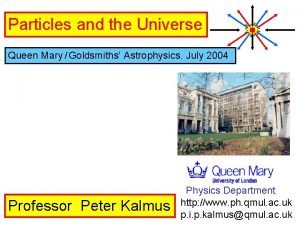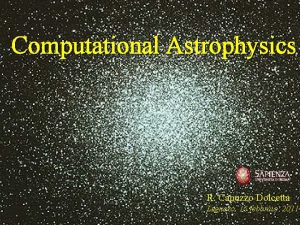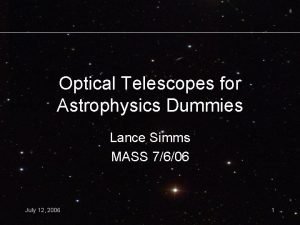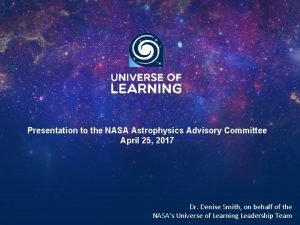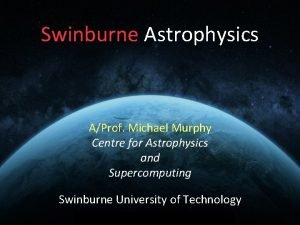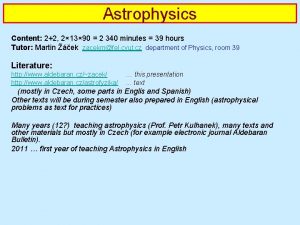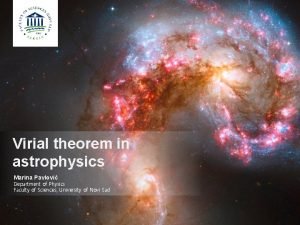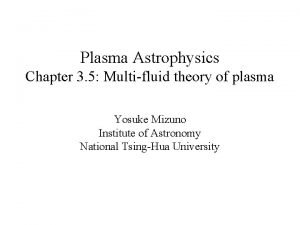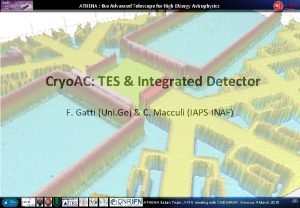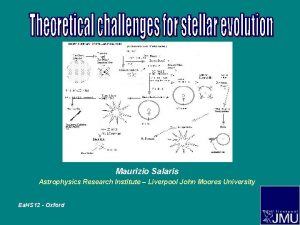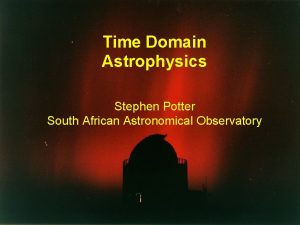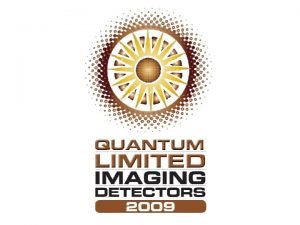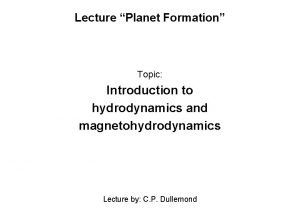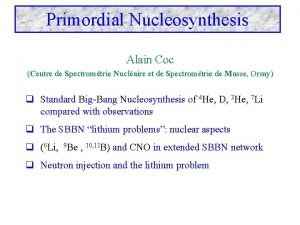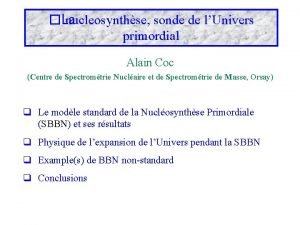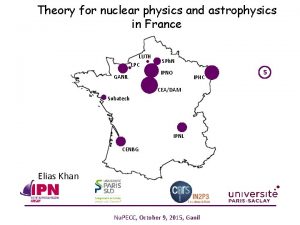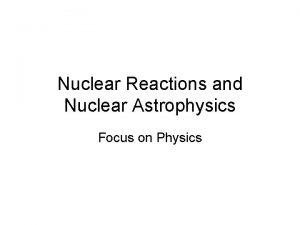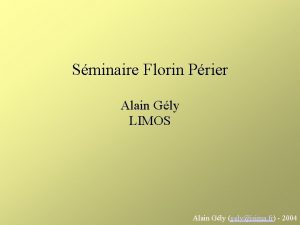Nuclear Astrophysics in France Alain Coc CSNSM Centre


![Origin of the Elements Already a long history [B 2 FH], also in France Origin of the Elements Already a long history [B 2 FH], also in France](https://slidetodoc.com/presentation_image_h/1fcff69e0d59e609f769e892c9cc3e93/image-3.jpg)










![Present and future instruments q q q GANIL-SPIRAL 1/2 [F. de Oliveira] Tandem-ALTO [D. Present and future instruments q q q GANIL-SPIRAL 1/2 [F. de Oliveira] Tandem-ALTO [D.](https://slidetodoc.com/presentation_image_h/1fcff69e0d59e609f769e892c9cc3e93/image-14.jpg)
- Slides: 14

Nuclear Astrophysics in France Alain Coc CSNSM (Centre de Sciences Nucléaires et de Sciences de la Matière, Orsay) +material from: F. Hammache, N. de Séréville, F. de Oliveira, V. Tatischeff, J. Margueron q 13 (IN 2 P 3 & CEA) Laboratories: CENBG (Bordeaux), GANIL (Caen), LPC Caen, LPSC (Grenoble), Subatech (Nantes), LUPM (Montpellier), CSNSM (Orsay), IPNO (Orsay), LLR (Palaiseau), APC (Paris), Irfu/SPh. N & Irfu/SAp (Saclay), IPHC (Strasbourg) q Collaboration with Institut National des Sciences de l'Univers (INSU) Laboratories: IAP (Paris), IRAP (Toulouse), . .

Nuclear Astrophysics q Motivations: Ø Source of stellar energy, stellar evolution Ø Origin of the elements (elemental and isotopic abundances) Ø Constraints on astrophysical models: Stellar surface abundances, nuclear gamma-ray emission, meteorites, … Ø Application in astroparticles, cosmological and fundamental physics: Cosmic rays, primordial nucleosynthesis, variation of constants, . … q An interdisciplinary domain by nature
![Origin of the Elements Already a long history B 2 FH also in France Origin of the Elements Already a long history [B 2 FH], also in France](https://slidetodoc.com/presentation_image_h/1fcff69e0d59e609f769e892c9cc3e93/image-3.jpg)
Origin of the Elements Already a long history [B 2 FH], also in France (in the 60’s) BBN, Li. Be. B ü Primordial nucleosynthesis ü ü Hydrogen burning ü ü Helium burning • ü e-process (iron peak) ü ü “x”-process (Li, Be, B): non- thermal nucleosynthesis r-process (“rapid” n-capture) s-process (“slow” n-capture) p-process (proton rich) Subsequent burning processes (12 C+12 C, 16 O+16 O)

Direct/indirect measurements Direct measurements Indirect measurements Model dependent Gamow window • Transfert reactions 13 C(7 Li, t)17 O [13 C( , n)16 O] • Resonant elastic diffusion 12 C( , )12 C [12 C( , )16 O] • Coulomb dissociation 6 Li( *, )D [D( , )6 Li] • Trojan Horse Method D(7 Li, )n [6 Li(p, )4 He] Very small cross sections NUPPEC Long Range Plan Most important reactions 12 C( , )16 O, 14 C( , )18 O, 18 O( , )22 Ne et 22 Ne( , )26 Mg Required precision: 10 %

Primordial Nucleosynthesis q BBN calculation of of 4 He, D, 3 He, 7 Li primordial abundances at Planck baryonic density compared with observations. q Used to constrain new physics e. g. variation of “constants”, exotic particles, . . . , but. . . q The Lithium Problem: a factor of 3 7 Li overproduction Ø Observations? New physics? or Ø A nuclear solution ? New 7 Be destruction channels (decays to 7 Li) 7 Be+3 He→ 10 C*, 7 Be+α→ 11 C* 7 Li from 7 Be decay

Search for unknown states in 10 C and 11 C • (3 He, t) reaction on 10, 11 B targets • with the Split-pole magnetic spectrometer at the Orsay Tandem He shell 10 B(3 He, t)10 C nat. B(3 He, t)11 C No obvious additional state in 10 C at ~ 15 Me. V No additional state in 11 C at ~ 7. 8 Me. V If present total 590 ke. V (95% CL) Rules out a nuclear solution [Hammache+ 2013]

(Explosive) Hydrogen burning: two examples The 17 O(p, )14 N and 17 O(p, γ)18 F reactions (PAPAP, now at Democritos) Spectroscopy of 19 Ne for 18 F(p, )15 O reaction Ganil experiment [Mountford+ 2012] / predictions [Dufour & Descouvemont 2007] 19 F(3 He, t)19 Ne experiment at Orsay ”on”/”off” resonnance [Chaffa+ 2005; 2007] [IPNO, York, Barcelona] in 2014

1/2 s-process neutron source: 13 C(α, n)16 O Ø s-process nucleosynthesis → half of the heavy elements Ø 90<A<209 low mass AGB stars 1 -3 M (T 108 K) → neutron source 13 C( , n)16 O Clark et al. Split-Pole Orsay Tandem : 13 C(7 Li, t)17 O Ecm 7. 380 5/27. 166 6. 359 13 C+ 5/2 - 2 ? S ? 6. 356 1/2+ 5. 939 1/2 - 4. 554 3/2 - 3. 055 1/2 - 17 O S =0. 25 6. 356 (1/2+) n S =0. 35 6. 356 (1/2+) S(E)=E (E)exp(2 ) 4. 143 16 O+n 1/2+ Orsay 3/2+ 0. 0 5/2+ The crucial role of the 6. 356 Me. V sub-threshold state is confirmed [Pellegriti+ 2008] Also applied to the most important reaction for He burning: 12 C(α, γ)15 O [Oulebsir+ 2012] Drotleff 93 Brune 93 Gamow peak

Study of 26 Al(n, p)26 Mg and 26 Al(n, α)23 Na Ø 1. 809 Me. V from 26 Al observed (COMPTEL, INTEGRAL, RHESSI) Ø Origin: explosive Ne/C burning Ø Important: 26 Al(n, p)26 Mg & 26 Al(n, α)23 Na Ø Inelastic reaction: 27 Al(p, p')27 Al* p & α in coincidence More than 30 new resonances above Sn (DSSSDs) → Γp/Γ & Γα/Γ [Benamara+ observed with Split-Pole: submitted] Opens up new possibilities e. g. Γp/Γ for 30 P(p, γ)

r-process Ø r-process nucleosynthesis → the other half of the heavy elements Ø Presently most favored astrophysical origin: coalescence of two neutron stars [S. Goriely, ULB, priv. comm. ] Ø No r-process path : 1000’s nuclei and 10000’s rates (n-capture, lifetimes, fission, neutrinos, . . ) ⇒ massive input from theory (phenomenological→microscopic) • Spectroscopy, decay, masses, t 1/2, Pn (ALTO, DESIR) • After post-acceleration ex : 130 Cd(d, p)131 Cd, et 134 Sn(d, p)135 Sn (SPIRAL 2)

Non thermal reactions Li. Be. B from CNO spallation, γ from solar flares [511 ke. V, 56 Fe*, 24 Mg*, 20 Ne*, 2. 22 Me. V, 12 C*, 16 O*; E/A= 2 -100 Me. V] and cosmic rays RHESSI Observations γ-ray production cross sections: • Projectile+target = p, + 12 C, 14 N, 16 O, Ne, 24 Mg, Si, Fe and 3 He +16 O, 24 Mg [Benhabiles+ 2010] • Energies: 5 to 25/40 Me. V (Orsay) → 66 Me. V (2014) and 200 Me. V (2015) [i. Temba, Orsay, Algiers] Total �-ray emission cross section

Nuclear physics of dense matter Neutron stars are the ultimate states of massive stars (i. e. with 10<M/M�<100) that exploded as SN. Nuclear conditions not reproducible in laboratory Theory [U. van Kolck talk] : Ø Eo. S of dense matter? (Internal composition, stiffness, 2 M� NS) Ø Transition from surface nuclei to core uniform matter via “pasta” ? Ø Superfluidity (cooling, “glitches”) Ø Electro-weak processes Ø Hyperonic matter Experiments: Ø nuclear masses, giant resonant modes, neutron-skin, pairing, beta -decay, radii, . . (GANILSPIRAL 2), hypernuclei, . . . Nucleonic matter Strangequark matter Exotic hadronic matter Adapted from Demorest et al. (2010)

Other important activities in France q Theory (“diluted” matter): Shell Model, Microscopic (cluster) Model, Mass models, Hauser–Feshbach (TALYS), . . . q Evaluations: Masses, Thermonuclear rates q Cosmology: BBN, variation of constants q Gamma-ray astronomy: Ø Observations (INTEGRAL, RHESSI): solar flares, (novae) Ø Instrumentation: next generation of Compton Telescope q (Micro-)meteorites Ø Collection: Antartica or from space missions Ø Extinct radioactivities (→formation of the solar system)
![Present and future instruments q q q GANILSPIRAL 12 F de Oliveira TandemALTO D Present and future instruments q q q GANIL-SPIRAL 1/2 [F. de Oliveira] Tandem-ALTO [D.](https://slidetodoc.com/presentation_image_h/1fcff69e0d59e609f769e892c9cc3e93/image-14.jpg)
Present and future instruments q q q GANIL-SPIRAL 1/2 [F. de Oliveira] Tandem-ALTO [D. Verney] ANDROMEDE (Orsay): 1 to 4 MV Van de Graaff and 12 C + 12 C reaction CACAO (Orsay): Radioactive target production facillity (e. g. 60 Fe, 26 Al, 44 Ti) Laser Mega. Joule (Bordeaux): screening studies, reaction rates. [Jiang+ 2010]
 Lesson 15 nuclear quest nuclear reactions
Lesson 15 nuclear quest nuclear reactions Fisión nuclear vs fision nuclear
Fisión nuclear vs fision nuclear Queen mary astrophysics
Queen mary astrophysics Astrophysics
Astrophysics Astrophysics for dummies
Astrophysics for dummies Nasa astrophysics advisory committee
Nasa astrophysics advisory committee Swinburne astrophysics
Swinburne astrophysics 13,90/2
13,90/2 Virial theorem in astrophysics
Virial theorem in astrophysics Astrophysics equations
Astrophysics equations Advanced telescope for high energy astrophysics
Advanced telescope for high energy astrophysics Maurizio salaris
Maurizio salaris Time domain astrophysics
Time domain astrophysics Rit astrophysics
Rit astrophysics Mhd equations
Mhd equations


